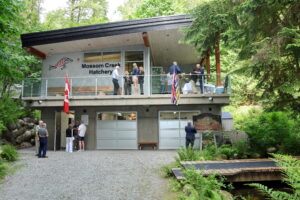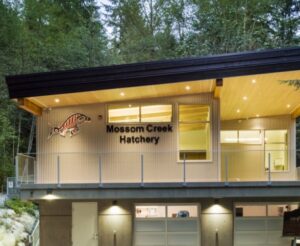Turning over rocks, wading in a stream, collecting small little bits and bobs that turn out to be amazing creatures when viewed through a magnifier … all in a day’s experience for a group of appreciative students from Anmore.
James McConville’s 7/8 grade class from Eagle Mountain Middle School recently spent a day at Mossom Creek learning first hand about some of the nature that is literally in their own back yard. The class hiked from their school down through the forest to the hatchery where Ruth Foster and Rod MacVicar showed the students the salmon eggs, alevins and fry. The students learned about the developmental stages of salmon as well as the procedures for caring for them. Then everyone put on rubber boots (supplied by the hatchery) and headed for the creek. The students’ tasks were to collect samples of aquatic insects from rocks in the stream bed by working with their rubber-gloved hands underwater. They wiped the rocks one by one and loosened the material on them. It was carried by the current into a D-shaped collecting net that a second student held in place just downstream.

Once they had a good collection, everyone headed into the education centre where Program Coordinator Cleone Todgham, along with Ruth and Rod, showed them how to use various tools to examine what they had found in the creek. There were lots of surprises and discoveries as they learned how to identify their aquatic insects. They found stoneflies, mayflies and caddisflies – all species that indicate a healthy stream ecosystem.


The class will do a similar study at Noon’s Creek later in the month and thus be able to compare their findings from the two streams. As their teacher (James McConville) reminded them, “This is the definition of science: comparing and assessing the results to see if there are differences between the two streams.”
James is a passionate educator and is particularly interested in an environmental education movement that is rapidly gaining interest. It is called “Place-based learning –
A relationship with ‘place’ has the potential to transform our practice as educators. As Gruenewald (2003a) states, “an understanding of it [place] is key to understanding the nature of our relationships with each other and the world” (p.622). Yet, renowned nature writer Hay (as cited in Gessner, 2005) has said that one of the worst things happening on the planet right now is that we are “forgetting about localities”, our place in the world where we take root, take responsibility and form community (p.16).”
To see the full article, go to on the Maple Ridge Environmental Website:
http://es.sd42.ca/2014/03/listening-place/
James notes how the program at Mossom Creek exemplifies ‘place-based’ learning. “For example, if my students, who live on both sides of the Mossom Creek watershed understand and value the important work at the centre, they will support it in ways that we can’t predict as adults. We want our local students to take responsibility for this place of nature.” In fact, the following Sunday several of his students returned to the hatchery and shared their new skills with other teenagers.
If you are interested in continuing this conversation with James, you can reach him on twitter or via email, or better yet, come to Mossom Creek any Sunday between 11:30 and 1:00 to personally experience what it has to offer.


